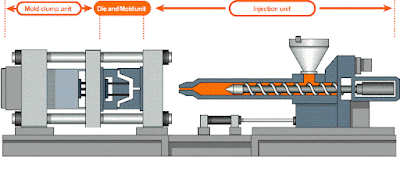What is Injection Molding Machine || Main Parts of Injection Molding Machine || Basics of Injection Molding Process
Injection molding:
Injection molding is the
process of using plastic to manufacture a wide range of parts and items. Even
though the process was invented as early as the 19th century, it still remains
one of the best ways to produce complex parts while keeping expenses under
control.
The injection molding machine uses custom-made molds to fill them out according to specifications, creating identical copies that can be customized in a variety of ways.
Main Parts of Injection
Molding Machine:
01. Rotating &
Reciprocating Screw
02. Barrel
03. Injection Chamber
04. Injection Cylinder
05. Feed Hopper
06. Nozzle
07. Mold Plates
08. Stationary Platen
09. Movable Platen
10. Sprue
11. Heater
12. Screw Motor Drive
13. Ejector Bar
14. Clamping Bar
15. Tie Bar
16. Clamping Cylinder
17. Hydraulic Cylinder
18. Clamping Motor Drive
19. Motor &
Gears for Screw Rotation
20. None Return Valve
Basics of Injection Molding Process:
There are six major steps in the injection molding process namely:
1. Clamping:
An injection molding machine consists of three basic parts: the mold, plus the clamping and injection units. The clamping unit holds the two halves of the injection mold together during the injection and cooling.
2. Injection:
During the injection phase plastic material, usually in the form of pellets, is loaded into a hopper on top of the injection unit. The pellets feed into a cylinder where they are heated until they reach molten form. Within the heating cylinder there is a motorized screw or ram that mixes the molten pellets and forces them to end of the cylinder. Once enough material has accumulated in front of the screw, the injection process begins. The molten plastic is inserted into the mold through a sprue (channel), while the pressure and speed are controlled by the screw.
 |
| Basics of Injection Molding Process |
3. Dwelling:
The dwelling phase consists of a pause in the injection process. Once the molten plastic has been injected into the mold, the pressure is applied to make sure all of the mold cavities are filled.
4. Cooling:
The plastic is allowed to cool to its solid form within the mold.
5. Mold Opening:
The clamping unit is opened, which separates the two halves of the mold.
6. Ejection:
An ejecting rod and plate eject the finished piece from the mold. The unused sprues and runners can be recycled for use again in future molds.









No comments